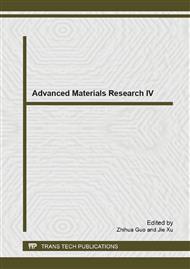p.364
p.369
p.374
p.381
p.386
p.391
p.396
p.403
p.408
Fabrication of ZnS Thin Film Buffer Layer in Solar Cell by Radio Frequency Sputtering Method
Abstract:
The present study aims to investigate the influence of Coring glass substrate temperature on the topography, deposition rate, crystal structure, optical, and electrical properties of ZnS thin films produced by magnetic radio frequency sputtering method. From plain view SEM micrographs, the pebble structure has shown in all ZnS thin films deposited at various substrate temperatures. Through higher substrate temperature, smaller ZnS grains can be obtained in the present study. From XRD analysis, ZnS thin film exhibits hexagonal Wurtzite structure. When thickness of ZnS thin film arrive 300nm, optical transmission rate can be above 85% regardless of substrate temperature and gets optical energy barrier of 3.9 eV. From electrical measurement, the variation of resistivity with temperature exhibits a linear relationship for ZnS thin film.
Info:
Periodical:
Pages:
386-390
Citation:
Online since:
February 2014
Authors:
Keywords:
Price:
Сopyright:
© 2014 Trans Tech Publications Ltd. All Rights Reserved
Share:
Citation:



